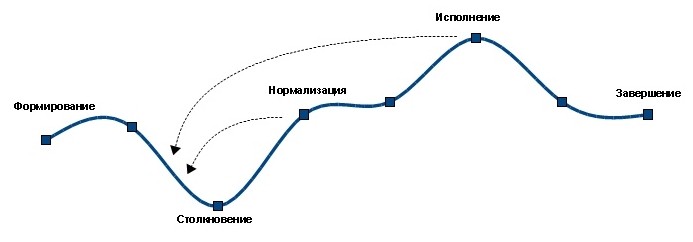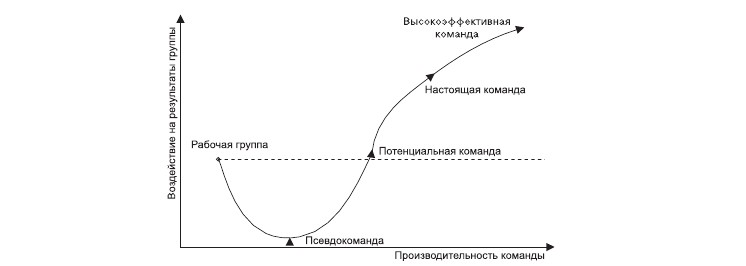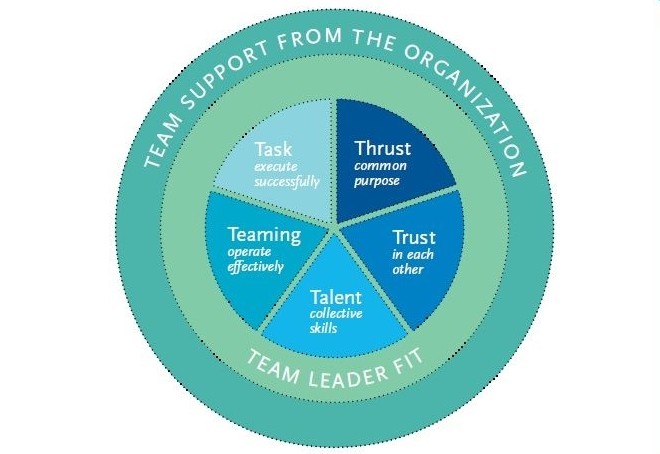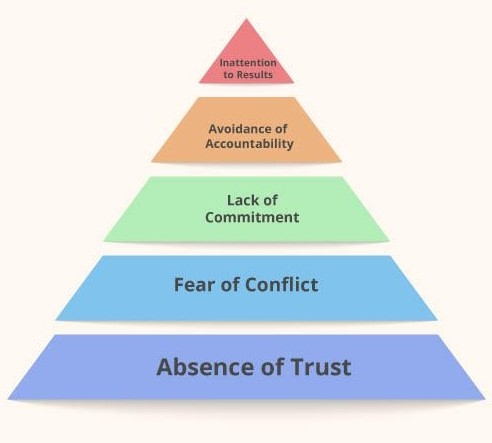5 models of effective team interaction
The choice of models and approaches to increase team efficiency is the eternal headache of product managers, team leads, business owners, HR, scientists and psychologists.
Any approach will always have supporters and opponents. Some of the popular models are focused on the communication strategy, some are more related to the corporate culture and the individual characteristics and talents of each team member. What factors help to correctly determine the effectiveness of teamwork?

Any effective team consists of individuals with the skills necessary to achieve individual and group goals.
It is extremely important that every specialist in an effective team be able to transmit their knowledge and skills to the whole group. In a successful team they know for sure about competent communication, active listening, the importance of feedback and timely response to critical moments.
All members of an effective team are responsible for achieving the goals and global strategy of the company and are motivated to succeed in business. They trust each other and support each other.
It would seem that everything is built on professionalism and a simple human relationship to each other. Why, then, need some models and techniques to improve efficiency?
All of them were designed to help figure out quickly and correctly which relationship models, strategies, tools should be applied in the case of a specific team for a particular business.
It is possible that some scientific approaches and original models will help to “shed light” on the stagnant problems within the team and unleash its potential.
The model is useful to all team members of any size from any industry.
Bruce Takmen described his theory in 1965. The author has identified four stages of the development team:
All these stage-by-stage stages are necessary for the team, if its plans include growing, developing and solving problems and finding the best solutions.
This organizational phase is dedicated to team building; At this time, conflict situations are deliberately avoided and each team member focuses on performing routine tasks. In the process of forming a team, it is important to accumulate information and impressions.
Team members get to know each other, meet, explore opportunities and requirements, accept common goals and strategies, and begin to implement them.
This stage is very important because the participants get to know each other, and for the manager this is a great chance to understand who prefers to work and how: on their own or in a group, how to cope with the load, etc.
Having formed into a single group, its members submit their ideas for discussion.
The most experienced team members usually determine if the team is ready to move on. Some focus on small things to avoid more serious questions in the future. This stage is necessary for the growth of the team.
Sometimes it can even turn out to be very “painful”, therefore it is important to pay attention to the patient attitude towards the process and tolerance. During Storming, team leaders should help participants to “smooth out” controversies and possible conflicts and set an example for professional conduct.
After discussing the ideas, the team proceeds to agree on a general plan. Not all ideas will be implemented, so some will have to abandon their own initiatives to act as a team.
All members of a cohesive group are ready to work towards a common goal. Everyone is ready to compromise, any hostility disappears.
By this stage, the team can already fully function and achieve results, find ways to do work smoothly and efficiently without inappropriate confrontations.
All group members are motivated, competent and can make decisions on their own. The leader’s mission is to evaluate the team’s performance, provide timely feedback and coordinate the personal aspirations of the participants.
Under certain circumstances, even the most highly effective teams may temporarily return to early stages of development.
In 1977, Tuckman, together with Mary Ann Jensen, added the fifth stage to the team development model - the stage of separation (adjourning).
The stage symbolizes the achievement of the goals and objectives set and, as a result, the decline in group activity.Joint activity of the team is terminated.

The authors of this model, John Katzenbach and Douglas Smith, described their approach in 1993 after examining many teams in different companies and industries. They identified the team as a small group of people with diverse skills, committed to common goals and a single strategy of behavior. The basics of the model were combined in the book " The Wisdom of Teams ".
The authors distinguish the types of teams in their development:
The authors visualized a model of effective teams using a triangle diagram.
There are three landmarks on which teams are equal:
Teamwork should be subject to the following principles:

Model T7 was also described in the 90s of the last century. Its authors tried to understand and study what factors influence the effectiveness of the team. In their opinion, there are 7 such factors - five internal and two external. They all start with the letter "T":
External factors:
Each of the above factors of this model can be detailed.
For high team performance, all five internal factors must be present in it.

The model proposed by Patrick Lension is also called the “5 Team Dysfunctions.” The book of the same name was released in 2005.
By studying this model, you will learn about the effectiveness of a working group based on what causes dysfunction, misunderstanding and conflicts within the group.
According to the author, all teams have the potential to be dysfunctional. The model includes 5 main dysfunctions of any team: lack of confidence, fear of conflict, lack of commitment, avoidance of responsibility, inattention to the results.
Model Lensioni visualized as a pyramid: you solve each dysfunction one by one from the bottom up.

Initially, the model was called "Five dynamic characteristics of cooperation and teamwork." Its authors, Frank LaFasto and Karl Larson, described their considerations in 2001, analyzing the results of a survey among representatives of 600 teams from various industries and fields.
Survey participants answered the simple question “What is an effective team?” As a result, the authors came up with and described a model consisting of five levels or components, each of which increases the likelihood of efficiency gains:
Which model most accurately reflects the degree of team efficiency? It depends on the case. The most effective team in the world, for sure, has not yet been assembled).
All of the models described will help identify the weaknesses of your team and direct your efforts to improve work efficiency.
Have you used similar efficiency models in your team? Maybe there are more interesting approaches?
Any approach will always have supporters and opponents. Some of the popular models are focused on the communication strategy, some are more related to the corporate culture and the individual characteristics and talents of each team member. What factors help to correctly determine the effectiveness of teamwork?

Any effective team consists of individuals with the skills necessary to achieve individual and group goals.
It is extremely important that every specialist in an effective team be able to transmit their knowledge and skills to the whole group. In a successful team they know for sure about competent communication, active listening, the importance of feedback and timely response to critical moments.
All members of an effective team are responsible for achieving the goals and global strategy of the company and are motivated to succeed in business. They trust each other and support each other.
It would seem that everything is built on professionalism and a simple human relationship to each other. Why, then, need some models and techniques to improve efficiency?
All of them were designed to help figure out quickly and correctly which relationship models, strategies, tools should be applied in the case of a specific team for a particular business.
It is possible that some scientific approaches and original models will help to “shed light” on the stagnant problems within the team and unleash its potential.
Takmen model
The model is useful to all team members of any size from any industry.
Bruce Takmen described his theory in 1965. The author has identified four stages of the development team:
- formation
- conflict
- normalizing
- executive
All these stage-by-stage stages are necessary for the team, if its plans include growing, developing and solving problems and finding the best solutions.
Forming
This organizational phase is dedicated to team building; At this time, conflict situations are deliberately avoided and each team member focuses on performing routine tasks. In the process of forming a team, it is important to accumulate information and impressions.
Team members get to know each other, meet, explore opportunities and requirements, accept common goals and strategies, and begin to implement them.
This stage is very important because the participants get to know each other, and for the manager this is a great chance to understand who prefers to work and how: on their own or in a group, how to cope with the load, etc.
Conflict Stage or Conflict of Interest (Storming)
Having formed into a single group, its members submit their ideas for discussion.
The most experienced team members usually determine if the team is ready to move on. Some focus on small things to avoid more serious questions in the future. This stage is necessary for the growth of the team.
Sometimes it can even turn out to be very “painful”, therefore it is important to pay attention to the patient attitude towards the process and tolerance. During Storming, team leaders should help participants to “smooth out” controversies and possible conflicts and set an example for professional conduct.
Stage rationing (Norming)
After discussing the ideas, the team proceeds to agree on a general plan. Not all ideas will be implemented, so some will have to abandon their own initiatives to act as a team.
All members of a cohesive group are ready to work towards a common goal. Everyone is ready to compromise, any hostility disappears.
Performance Stage (Performing)
By this stage, the team can already fully function and achieve results, find ways to do work smoothly and efficiently without inappropriate confrontations.
All group members are motivated, competent and can make decisions on their own. The leader’s mission is to evaluate the team’s performance, provide timely feedback and coordinate the personal aspirations of the participants.
Under certain circumstances, even the most highly effective teams may temporarily return to early stages of development.
In 1977, Tuckman, together with Mary Ann Jensen, added the fifth stage to the team development model - the stage of separation (adjourning).
The stage symbolizes the achievement of the goals and objectives set and, as a result, the decline in group activity.Joint activity of the team is terminated.

Model Katzenbach and Smith
The authors of this model, John Katzenbach and Douglas Smith, described their approach in 1993 after examining many teams in different companies and industries. They identified the team as a small group of people with diverse skills, committed to common goals and a single strategy of behavior. The basics of the model were combined in the book " The Wisdom of Teams ".
The authors distinguish the types of teams in their development:
- A working group where participants interact to exchange information and experiences.
- A pseudo team in which its members can increase work efficiency, but make no effort to do this.
- A potential team in which they understand a common goal and its necessity and try to work out effective ways of cooperation.
- This team consists of participants who have complementary skills and abilities. They are aware of common goals and objectives and work together on them.
- Highly effective team with the characteristics of this group and promoting the individual development of its members. Its results usually exceed expectations.
The authors visualized a model of effective teams using a triangle diagram.
There are three landmarks on which teams are equal:
- collective products and achievements
- work results
- individual growth
Teamwork should be subject to the following principles:
- selection of team members according to their skills, abilities and capabilities
- definition of joint objectives and rules of conduct
- team members are aware of their rights
- continuous interaction in a team, allocation of necessary time for communication
- feedback, rewards and recognition.

T7 Team Performance Model
Model T7 was also described in the 90s of the last century. Its authors tried to understand and study what factors influence the effectiveness of the team. In their opinion, there are 7 such factors - five internal and two external. They all start with the letter "T":
- Thrust (Focus) - focusing on the essence. This is a common desire for what should be done by the team.
- Trust to each other within a team.
- Talent (Talent) - the ability of team members.
- Team Skills ( Team Skills ) - the ability to effectively and productively act as a team.
- Task Skills (Ability to solve problems) - the successful implementation of tasks assigned to the team.
External factors:
- Team Leader Fit - the degree to which a leader meets the needs of team members.
- Team Support (Support team from the company) - a measure in which the management of the company allows the team to express themselves.
Each of the above factors of this model can be detailed.
For high team performance, all five internal factors must be present in it.

Model Lensioni
The model proposed by Patrick Lension is also called the “5 Team Dysfunctions.” The book of the same name was released in 2005.
By studying this model, you will learn about the effectiveness of a working group based on what causes dysfunction, misunderstanding and conflicts within the group.
According to the author, all teams have the potential to be dysfunctional. The model includes 5 main dysfunctions of any team: lack of confidence, fear of conflict, lack of commitment, avoidance of responsibility, inattention to the results.
- Lack of trust occurs when team members show their vulnerability and are unwilling to admit their mistakes and weaknesses. They do not ask for help.
- Fear of conflict . Without trust, it is impossible to fully communicate. In such cases, internal conflicts can turn into veiled discussions and closed discussions.
- Lack of commitment - without constructive discussion of conflicts, it is difficult for everyone in the team to contribute to the solution. Ambiguity appears.
- Avoid liability . People do not want to hold others accountable for their work.
- Inattention to the results . If group members do not take responsibility, they tend to put their personal needs above team goals. If the team has lost sight of the need to achieve results - the general focus is lost.
Model Lensioni visualized as a pyramid: you solve each dysfunction one by one from the bottom up.

Model LaFasto and Larson
Initially, the model was called "Five dynamic characteristics of cooperation and teamwork." Its authors, Frank LaFasto and Karl Larson, described their considerations in 2001, analyzing the results of a survey among representatives of 600 teams from various industries and fields.
Survey participants answered the simple question “What is an effective team?” As a result, the authors came up with and described a model consisting of five levels or components, each of which increases the likelihood of efficiency gains:
- Member of the team . This is the first step in choosing the right group members. What are their skills and behavior, personal behavioral style.
- Team Relations . Acceptable teamwork promotes healthy working relationships between participants.
- Problem solving . Healthy relationships allow you to solve problems together.
- Team management . The right approach to leadership leads to successful teamwork.
- The organizational structure . This is what contributes to responsible team members and leads to clarity.
Which model most accurately reflects the degree of team efficiency? It depends on the case. The most effective team in the world, for sure, has not yet been assembled).
All of the models described will help identify the weaknesses of your team and direct your efforts to improve work efficiency.
Have you used similar efficiency models in your team? Maybe there are more interesting approaches?
